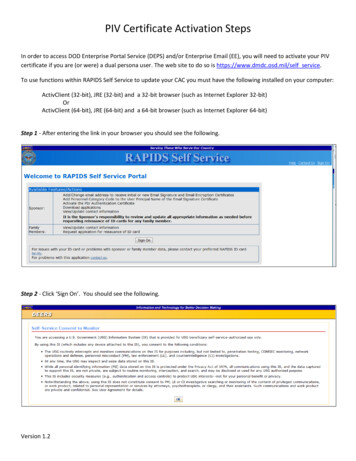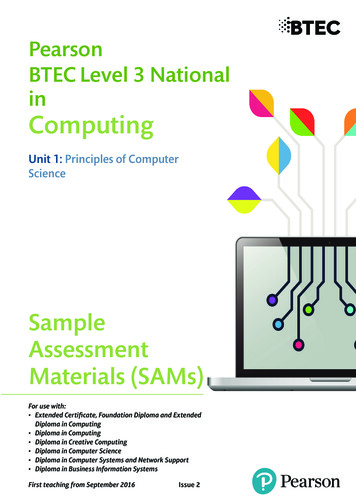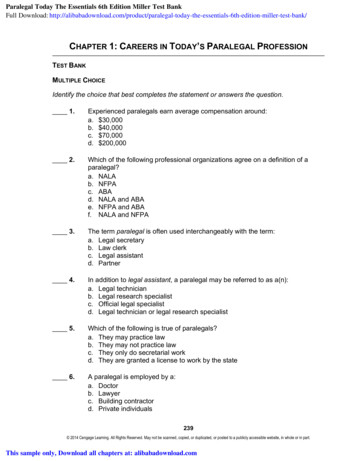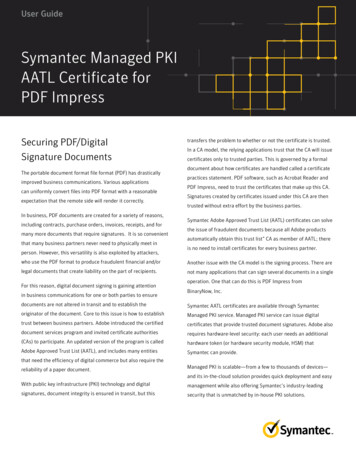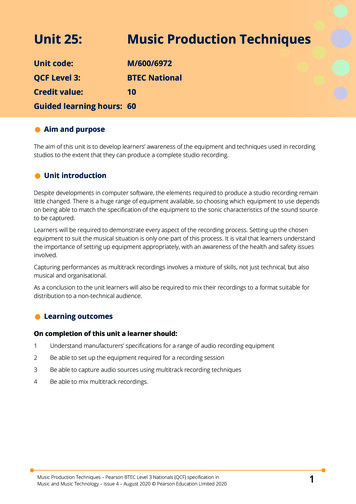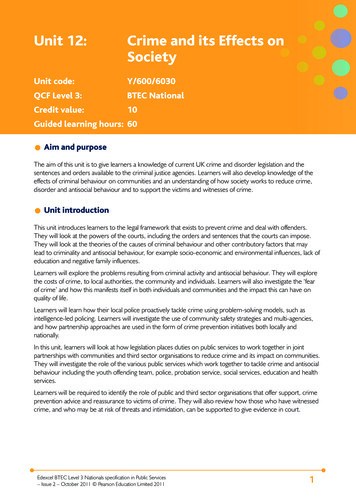
Transcription
PearsonBTEC Level 3 Certificate inPersonal TrainingSpecificationBTEC specialist qualificationFirst teaching March 2012Issue 2
Edexcel, BTEC and LCCI qualificationsEdexcel, BTEC and LCCI qualifications are awarded by Pearson, the UK’s largest awardingbody offering academic and vocational qualifications that are globally recognised andbenchmarked. For further information, please visit our qualifications website atqualifications.pearson.com. Alternatively, you can get in touch with us using the details onour contact us page at qualifications.pearson.com/contactusAbout PearsonPearson is the world's leading learning company, with 35,000 employees in more than 70countries working to help people of all ages to make measurable progress in their livesthrough learning. We put the learner at the centre of everything we do, because whereverlearning flourishes, so do people. Find out more about how we can help you and yourlearners at qualifications.pearson.comThis specification is Issue 2. Key changes are listed in the summary table on the next page.We will inform centres of any changes to this issue. The latest issue can be found on thePearson website: qualifications.pearson.comThis qualification was previously known as:Edexcel BTEC Level 3 Certificate in Personal Training (QCF)The QN remains the same.References to third party material made in this specification are made in good faith. Pearsondoes not endorse, approve or accept responsibility for the content of materials, which may besubject to change, or any opinions expressed therein. (Material may include textbooks,journals, magazines and other publications and websites.)All information in this specification is correct at time of going to publication.ISBN: 978 1 446 93997 0All the material in this publication is copyright Pearson Education Limited 2017
Summary of Pearson BTEC Level 3 Certificate in PersonalTraining specification Issue 2 changesSummary of changes made between previous issue and thiscurrent issueSectionnumberAll references to QCF have been removed throughout the specificationDefinition of TQT addedSection 1Definition of sizes of qualifications aligned to TQTSection 1TQT value addedSection 2Reference to credit transfer within the QCF removedSection 6QCF references removed from unit titles and unit levels in all unitsSection 11Guided learning definition updatedSection 11Earlier issue(s) show(s) previous changes.If you need further information on these changes or what they mean, contact us via our websiteat: tml.
Contents123Introducing BTEC Specialist qualificationsWhat are BTEC Specialist qualifications?1Sizes of Specialist qualifications1Qualification summary and key information2Qualification title and Qualification Number3Objective of the qualification3Apprenticeships3Relationship with National Occupational Standards4Centre resource requirementsGeneral resource requirements41Qualification structurePearson BTEC Level 3 Certificate in Personal Training55665Assessment76Recognising prior learning and achievement8Recognition of Prior Learning87Quality assurance of centres98Programme delivery109Access and recruitment1110 Access to qualifications for learners with disabilitiesor specific needs1211 Units13Unit format13Unit title13Unit reference number13Level13Credit value13Guided Learning Hours13Unit aim13Essential resources13Learning outcomes14Assessment criteria14
Unit amplification14Information for tutors14Unit 1: Health, Safety and Welfare in a Fitness Environment15Unit 2: Principles of Exercise, Fitness and Health24Unit 3: Know How to Support Clients who Take Part in Exercise andPhysical Activity37Unit 4: Anatomy and Physiology for Exercise and Health44Unit 5: Programming Personal Training with Clients60Unit 6: Delivering Personal Training Sessions79Unit 7:Applying the Principles of Nutrition to a Physical Activity Programme9212 Further information and useful publications11213113Professional development and trainingContact us113Annexe A114Progression opportunities114Annexe B116Wider curriculum mappingAnnexe CNational Occupational Standards/mapping with NOSAnnexe DMapping to Level 2 Functional Skills116117117118118
Purpose of this specificationThis specification sets out: the qualification’s objective any other qualification which a learner must have completed before taking thequalification any prior knowledge, skills or understanding which the learner is required tohave before taking the qualification units which a learner must have completed before the qualification will beawarded and any optional routes any other requirements which a learner must have satisfied before the learnerwill be assessed or before the qualification will be awarded the knowledge, skills and understanding which will be assessed as part of thequalification (giving a clear indication of their coverage and depth) the method of any assessment and any associated requirements relating to it the criteria against which learners’ level of attainment will be measured (such asassessment criteria) any specimen materials any specified levels of attainment.
1Introducing BTEC Specialist qualificationsWhat are BTEC Specialist qualifications?BTEC Specialist qualifications are work-related qualifications available from Entry toLevel 3 in a range of sectors. They give learners the knowledge, understanding andskills they need to prepare for employment in a specific occupational area. Thequalifications also provide career development opportunities for those already inwork. The qualifications may be offered as full-time or part-time courses in schoolsor colleges. Training centres and employers may also offer these qualifications.Sizes of Specialist qualificationsFor all regulated qualifications, we specify a total number of hours that learners areexpected to undertake in order to complete and show achievement for thequalification – this is the Total Qualification Time (TQT). The TQT value indicatesthe size of a qualification.Within the TQT, we identify the number of Guided Learning Hours (GLH) that acentre delivering the qualification needs to provide. Guided learning meansactivities that directly or immediately involve tutors and assessors in teaching,supervising, and invigilating learners, for example lectures, tutorials, onlineinstruction and supervised study.As well as guided learning, there may be other required learning that is directed bytutors or assessors. This includes, for example, private study, preparation forassessment and undertaking assessment when not under supervision, such aspreparatory reading, revision and independent research.As well as TQT and GLH, qualifications can also have a credit value – equal to onetenth of TQT, rounded to the nearest whole number.TQT and credit values are assigned after consultation with users of thequalifications.BTEC Specialist qualifications are available in the following sizes: Award – a qualification with a TQT value of 120 or less(equivalent to a range of 1–12 credits) Certificate – a qualification with a TQT value in the range of 121–369(equivalent to a range of 13–36 credits) Diploma – a qualification with a TQT value of 370 or more(equivalent to 37 credits and above).Specification –Pearson BTEC Level 3 Certificate specialist qualification in Personal Training –Issue 12 – March 2017 Pearson Education Limited 20171
2Qualification summary and keyinformationQualification titlePearson BTEC Level 3 Certificate inPersonal TrainingQualification Number (QN)600/4543/7Date registrations can be made01/02/2012Age range that the qualificationis approved for18 Credit value36AssessmentCentre-devised assessment (internal assessment)Total Qualification Time (TQT)360Guided learning hours245Grading informationThe qualification and units are at pass grade.Entry requirementsNo prior knowledge, understanding, skills orqualifications are required before learners registerfor this qualification. However, centres mustfollow the Pearson Access and Recruitment policy(see Access and Recruitment, Section 9).219 Specification –Pearson BTEC Level 3 Certificate specialist qualification in Personal Training –Issue 12 – March 2017 Pearson Education Limited 2017
Qualification title and Qualification NumberCentres will need to use the Qualification Number (QN) when they seek publicfunding for their learners. Qualifications eligible and funded forpost-16-year-olds can be found on the funding Hub. The Skills Funding Agency alsopublishes a funding catalogue that lists the qualifications available for 19 funding.The qualification title, QN and URNs are on learners’ final certificationdocumentation. Learners need to know this when they are recruited by the centreand registered with Pearson. Further information about certification is in thePearson Information Manual on our website, qualifications.pearson.com.The QN for the qualification in this publication is 600/4543/7.Objective of the qualificationThe Pearson BTEC Level 3 Certificate in Personal Training is for learners who workin, or want to work in the sports, leisure and recreation industries.It gives learners the opportunity to: develop a range of skills and techniques, personal skills and attributes essentialfor successful performance in working life achieve a nationally-recognised level 3 qualification achieve a licence to practise develop their own personal growth and engagement in learning.ApprenticeshipsThe SSC, SkillsActive approve the Pearson BTEC Level 3 Certificate in PersonalTraining as a knowledge component of the Advanced Level ApprenticeshipFramework in Advanced Fitness.This apprenticeship framework is required in the health and fitness industry toprovide a highly-skilled workforce, including advanced instructors, personal trainersand studio coordinators; delivering the government agenda for a healthier nation.The advanced level programme can provide a progression opportunity forapprentices on an intermediate level programme as well as progression for thosealready working in the sector. This advanced programme is also suitable for thosewho wish to change their careers and retrain to enter the sector at this level.Apprentices will be given the opportunity to gain literacy and numeracyqualifications alongside their industry related skills and qualifications.It is not a mandatory part of this framework to achieve ICT qualifications, althoughapprentices are encouraged to take every opportunity to broaden their skills base.There are no pre-defined entry routes into the Advanced fitness apprenticeship,however learners wishing to progress into this apprenticeship programme couldcome from a variety of backgrounds with a variety of qualifications. These mightinclude diplomas, GCSEs, A levels or vocational training routes such as intermediatelevel apprenticeships.Learners can also progress into this advanced level apprenticeship from theIntermediate level apprenticeship in exercise and fitness or any other intermediatelevel apprenticeship in the active leisure and learning sector.Specification –Pearson BTEC Level 3 Certificate specialist qualification in Personal Training –Issue 12 – March 2017 Pearson Education Limited 20173
Learners can also progress into this advanced level apprenticeship if they arealready employed in the sector and wish to develop their knowledge and skills toprogress their careers.Learners can also progress into this advanced apprenticeships programme fromemployment in a different sector as a career change.On completion of this programme, apprentices can progress into full-timeemployment in a variety of roles, ranging from personal trainer to workingalongside a GP doing GP referral. They can also progress onto a variety ofvocational qualifications allowing them to further specialise for example in anteand post-natal exercise or dealing with older adults.Once level 3 qualifications are completed, there is a direct progression route forthose interested in becoming specialist instructors for the conditions listed below: cardiac falls stroke mental health back pain obesity/diabetes military rehab.On completion of this programme, learners can progress onto further or highereducation institutes or to study a variety of subjects ranging from those which aresports and fitness specific, such as sports and exercise science or sports nutrition,to general subjects such as management or business studies.Further details on these progression routes are available on the Register of ExerciseProfessionals website, www.exerciseregister.orgPlease also check the SkillsActive Careers site for further information on progressionopportunities: http: //www.skillsactive.com/careers/Relationship with National Occupational StandardsWhere relevant, Pearson BTEC level 3 qualifications are designed to provide some ofthe underpinning knowledge and understanding for the National OccupationalStandards (NOS), as well as developing practical skills in preparation for work andpossible achievement of NVQs in due course. NOS form the basis of NationalVocational Qualifications (NVQs). Pearson BTEC level 3 qualifications do not purportto deliver occupational competence in the sector, which should be demonstrated ina work context.4Specification –Pearson BTEC Level 3 Certificate specialist qualification in Personal Training –Issue 12 – March 2017 Pearson Education Limited 2017
3Centre resource requirementsAs part of the approval process, centres must make sure that the resourcesrequirements below are in place before offering the qualification.General resource requirements Centres must have appropriate physical resources (for example equipment, IT,learning materials, teaching rooms) to support the delivery and assessment ofthe qualification. Staff involved in the assessment process must have relevant expertise andoccupational experience. There must be systems in place to make sure continuing professionaldevelopment for staff delivering the qualification. Centres must have appropriate health and safety policies in place relating to theuse of equipment by learners. Centres must deliver the qualifications in accordance with current equalitylegislation.Specification –Pearson BTEC Level 3 Certificate specialist qualification in Personal Training –Issue 12 – March 2017 Pearson Education Limited 20175
4Qualification structurePearson BTEC Level 3 Certificate in Personal TrainingThe learner will need to meet the requirements outlined in the box below beforePearson can award the qualification.Number of credits that must be achievedUnitURNMandatory units1T/600/9016Health, safety and welfare in afitness environment2A/600/9017336CreditGLH2216Principles of exercise, fitness andhealth2428M/600/9015Know how to support clients whotake part in exercise and physicalactivity22134A/600/9051Anatomy and physiology for exerciseand health36435F/600/9052Programming Personal Training withClients37406J/600/9053Delivering personal training sessions39587L/600/9054Applying the Principles of Nutritionto a Physical Activity Program36406LevelSpecification –Pearson BTEC Level 3 Certificate specialist qualification in Personal Training –Issue 12 – March 2017 Pearson Education Limited 2017
5AssessmentAssessment methodAll the units in this qualification are assessed through centre-devised assessments.Centre-devised assessment (internal assessment)Each unit has specified learning outcomes and assessment criteria. To pass aninternally assessed unit, learners must meet all the assessment criteria. Centresmay find it helpful if learners index and reference their evidence to the relevantlearning outcomes and assessment criteria.Centres need to write assignment briefs for the learners to show what evidence isrequired. Assignment briefs should indicate clearly, which assessment criteria arebeing targeted.Assignment briefs and evidence produced by learners must also meet any additionalrequirements in the Information for tutors section of the unit.Unless otherwise indicated within Information for tutors, the centre can decide whatform assessment evidence will take (eg performance observation, presentations,projects, tests, extended writing) as long as the methods chosen allow learners toproduce valid, sufficient and reliable evidence of meeting the assessment criteria.Centres are encouraged to provide learners with realistic scenarios and maximisethe use of practical activities in delivery and assessment.Opportunities to link the delivery and assessment of units with other units shouldalso be encouraged to avoid over assessment.Further guidance about internal assessment is on the Pearson website. SeeSection 12 for further details.Specification –Pearson BTEC Level 3 Certificate specialist qualification in Personal Training –Issue 12 – March 2017 Pearson Education Limited 20177
6Recognising prior learning andachievementRecognition of Prior LearningRecognition of Prior Learning (RPL) is a method of assessment (leading to theaward of credit) that considers whether a learner can demonstrate that they canmeet the assessment requirements for a unit through knowledge, understanding orskills they already possess and so do not need to develop through a course oflearning.Pearson encourages centres to recognise learners’ previous achievements andexperiences in and outside the workplace, as well as in the classroom. RPL providesa route for the recognition of the achievements resulting from continuous learning.RPL enables recognition of achievement from a range of activities using any validassessment methodology. If the assessment requirements of a given unit orqualification have been met, the use of RPL is acceptable for accrediting a unit,units or a whole qualification. Evidence of learning must be sufficient, reliable andvalid.Further guidance is available in the policy document Recognition of Prior LearningPolicy, which is on the Pearson website.8Specification –Pearson BTEC Level 3 Certificate specialist qualification in Personal Training –Issue 12 – March 2017 Pearson Education Limited 2017
7Quality assurance of centresQuality assurance is at the heart of vocational qualifications. The centre assessesBTEC qualifications. The centre will use quality assurance to make sure that theirmanagers, internal verifiers and assessors are standardised and supported. Pearsonuse quality assurance to check that all centres are working to national standards. Itgives us the opportunity to identify and provide support, if needed, to safeguardcertification. It also allows us to recognise and support good practice.For the qualifications in this specification, the Pearson quality assurance model willfollow one of the processes listed below.1Delivery of the qualification as part of a BTEC apprenticeship (single clickregistration): an annual visit by a Standards Verifier to review centre-wide qualityassurance systems and sampling of internal verification and assessordecisions.2Delivery of the qualification outside the apprenticeship: an annual visit to the centre by a Centre Quality Reviewer to review centrewide quality assurance systems Lead Internal Verifier accreditation. This involves online training andstandardisation of Lead Internal Verifiers using our OSCA platform, accessedvia Pearson Online. Please note that not all qualifications will include LeadInternal Verifier accreditation. Where this is the case, we will annuallyallocate a Standards Verifier to conduct postal sampling of internalverification and assessor decisions for the Principal Subject Area.For further details, go to the UK BTEC Quality Assurance Handbook on our website:qualifications.pearson.comSpecification –Pearson BTEC Level 3 Certificate specialist qualification in Personal Training –Issue 12 – March 2017 Pearson Education Limited 20179
8Programme deliveryCentres are free to offer the qualifications using any mode of delivery (for examplefull time, part time, evening only, distance learning) that meets their learners’needs.Whichever mode of delivery is used, centres must make sure that learners haveaccess to the resources identified in the specification and to the subject specialistsdelivering the units.Those planning the programme should aim to enhance the vocational nature of thequalification by: liaising with employers to make sure a course is relevant to learners’ specificneeds accessing and using non-confidential data and documents from learners’workplaces developing up-to-date and relevant teaching materials that make use ofscenarios that are relevant to the sector giving learners the opportunity to apply their learning in practical activities including sponsoring employers in the delivery of the programme and, whereappropriate, in the assessment making full use of the variety of experience of work and life that learners bringto the programme.Where a unit is externally assessed, it is essential that learners havecovered all of the Unit amplification before they are tested.Centres must make sure that current legislation is included when it is part of a unit.10Specification –Pearson BTEC Level 3 Certificate specialist qualification in Personal Training –Issue 12 – March 2017 Pearson Education Limited 2017
9Access and recruitmentPearson’s policy regarding access to our qualifications is that: they should be available to everyone who is capable of reaching the requiredstandards they should be free from any barriers that restrict access and progression there should be equal opportunities for all those wishing to access thequalifications.Centres are required to recruit learners to BTEC specialist qualifications withintegrity.Applicants will need relevant information and advice about the qualification to makesure it meets their needs.Centres should review the applicant’s prior qualifications and/or experience,considering whether this profile shows that they have the potential to achieve thequalification.For learners with disabilities and specific needs, this review will need to takeaccount of the support available to the learner during teaching and assessment ofthe qualification. The review must take account of the information and guidance inSection 10, Access to qualifications for learners with disabilities or specific needs.Specification –Pearson BTEC Level 3 Certificate specialist qualification in Personal Training –Issue 12 – March 2017 Pearson Education Limited 201711
10 Access to qualifications for learners withdisabilities or specific needsEquality and fairness are central to our work. Pearson’s Equality Policy requires thatall learners should have equal opportunity to access our qualifications andassessments and that our qualifications are awarded in a way that is fair to everylearner.We are committed to making sure that: learners with a protected characteristic (as defined by the Equality Act 2010)are not, when they are undertaking one of our qualifications, disadvantaged incomparison to learners who do not share that characteristic all learners achieve the recognition they deserve from undertaking aqualification and that this achievement can be compared fairly to theachievement of their peers.Learners taking a qualification may be assessed in British sign language or Irishsign language where it is permitted for the purpose of reasonable adjustments.Details on how to make adjustments for learners with protected characteristics arein the policy document Reasonable Adjustment and Special Considerations for BTECand Pearson NVQ Qualifications, which are on our html12Specification –Pearson BTEC Level 3 Certificate specialist qualification in Personal Training –Issue 12 – March 2017 Pearson Education Limited 2017
11 UnitsUnit formatUnits have the following sections.Unit titleThis is the formal title of the unit that will appear on the learner’s certificate.Unit reference numberEach unit is assigned a unit reference number that appears with the unit title on theRegister of Regulated Qualifications.LevelAll units and qualifications have a level assigned to them. The level assigned isinformed by the level descriptors by Ofqual, the qualifications regulator.Credit valueWhen a learner achieves a unit, they gain the specified number of credits.Guided Learning HoursGuided Learning Hours (GLH) is the number of hours that a centre delivering thequalification needs to provide. Guided learning means activities that directly orimmediately involve tutors and assessors in teaching, supervising, and invigilatinglearners, for example lectures, tutorials, online instruction and supervised study.Unit aimThis gives a summary of what the unit aims to do.Essential resourcesThis section lists any specialist resources that are needed to deliver the unit. Thecentre will be asked to make sure that these resources are in place when it seeksapproval from Pearson to offer the qualification.Specification –Pearson BTEC Level 3 Certificate specialist qualification in Personal Training –Issue 12 – March 2017 Pearson Education Limited 201713
Learning outcomesThe learning outcomes of a unit set out what a learner knows, understands or isable to do as the result of a process of learning.Assessment criteriaThe assessment criteria specify the standard required by the learner to achieve thelearning outcome.Unit amplificationThis section gives further clarification on what a learner needs to know to achieve alearning outcome. Information in brackets gives exemplification for specific areas ofknowledge.Information for tutorsThis section gives tutors’ information on delivery and assessment. It usuallycontains the following subsections. Delivery – explains the content’s relationship to the learning outcomes andoffers guidance on possible approaches to delivery. Assessment – gives information about the evidence that learners must produce,together with any additional guidance if appropriate. This section should be readin conjunction with the assessment criteria. Indicative resource materials – lists resource materials that can be used tosupport the teaching of the unit, for example books, journals and websites.14Specification –Pearson BTEC Level 3 Certificate specialist qualification in Personal Training –Issue 12 – March 2017 Pearson Education Limited 2017
Unit 1:Health, Safety andWelfare in a FitnessEnvironmentUnit code:T/600/9016Level:2Credit value:2Guided learning hours:16Unit aimThe aim of this unit is to develop learner knowledge and understanding of therequirements for health, safety and welfare in a fitness environment. The learnerwill understand how to assess and control any hazards and risks that compromisethe health, safety and welfare of staff and customers. The unit also aims to developlearner knowledge and understanding of safeguarding children and vulnerableadults.Learners will explore the organisational procedures, legislation and regulations inplace to ensure a healthy, safe and secure work environment for employees,customers and visitors.Learners will have the opportunity to investigate the main hazards, how to riskassess these hazards, how to control the associated risks and the securityprocedures that may be in place within fitness environments.Finally, learners will explore the associated organisational procedures and policies,and the statutory agencies responsible, for safeguarding children and vulnerableadults.Essential resourcesFor this unit, centres need to give learners access to: computers, the internet and library facilities to enable them to carry outresearch, for example on current legislation and regulations information on key factors that influence health and safety, specifically in thefitness sector. This information can be obtained from the Health and SafetyExecutive, governing bodies, local authorities and local education authorities.It would also be beneficial for learners to see examples of the types of tools,equipment and materials needed to deal with the hazards found in a fitnessenvironment.Specification –Pearson BTEC Level 3 Certificate specialist qualification in Personal Training –Issue 12 – March 2017 Pearson Education Limited 201715
Learning outcomes, assessment criteria and unit amplificationTo pass this unit, the learner needs to demonstrate that they can meet all the learning outcomes for the unit. The assessment criteriadetermine the standard required to achieve the unit.Learning outcomesAssessment criteriaUnit amplification11.1Identify the types ofemergencies that may occur in afitness environmentDepending on the type of workplaceDescribe the roles that differentstaff and external services playduring an emergencyInternal staff eg contacting and advising emergency services,informing colleagues when emergency services arrive, responding onsite as situation occurs, responding within limits of own competenceand authority, seeking help and advice as appropriateUnderstandemergencyprocedures in afitnessenvironment1.2Types eg fire, chemical leaks, bomb scare, power cut, structuralfailure, medical emergency, accidents, threatening behaviour, missingpersonsSpecific roles of external services eg paramedics, police, fire service161.3Explain the importance offollowing emergency procedurescalmly and correctlyImportance eg maintain safely of other staff, customers and visitors,contact relevant emergency services, resolve emergency situationsafely and quickly1.4Describe how to maintain thesafety of people involved intypical emergencies, includingchildren, older people anddisabled peopleTake appropriate actions eg stop the activity, give clear and correctinstructions, evacuate the area and move people to a safe areaEnsure evacuation route accessible by all eg wheelchair usersContact relevant people eg parents, emergency servicesSpecification –Pearson BTEC Level 3 Certificate specialist qualification in Personal Training –Issue 12 – March 2017 Pearso
and registered with Pearson. Further information about certification is in the Pearson Information Manual on our website, qualifications.pearson.com. The QN for the qualification in this publication is 600/4543/7. Objective of the qualification The Pearson BTEC Level 3 Certifica




